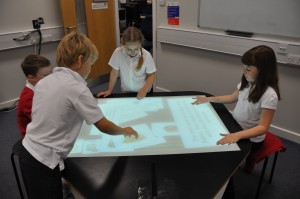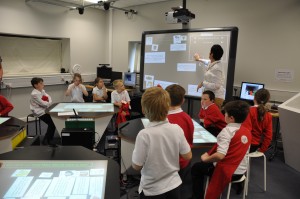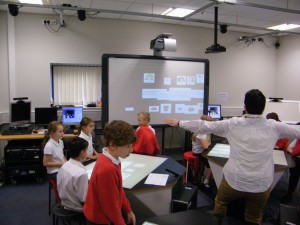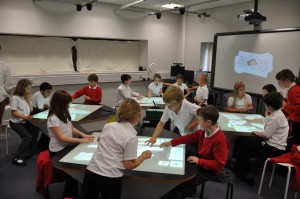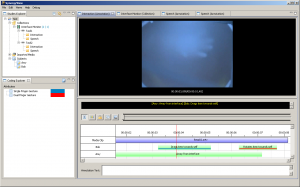software
New Publication
The SynergyNet team’s newest publication focuses on computer science aspects of the project:
Richardson, T., Burd, L. & Smith, S. (2013) Guidelines for supporting real-time multi-touch applications. Journal of Software: Practice and Experience. DOI: 10.1002/spe.2183
Abstract:
Multi-touch driven user interfaces are becoming increasingly prevalent because of their intuitiveness and because of the reduction in the associated hardware costs. In recognition of this trend, multi-touch software frameworks (MSFs) have begun to emerge. These frameworks abstract the low level issues of multi-touch software development and deployment. MSFs therefore enable software developers who are unfamiliar with the complexities of multi-touch software development to implement and deploy multi-touch applications more easily. However, some multi-touch applications have real-time system requirements, and at present, no MSFs provide support for the development and deployment of such real-time multi-touch applications. The implication of this is that software developers are unable to take advantage of MSFs and, therefore, are forced to handle the complexities of multi-touch and real-time systems development and deployment for themselves in an ad hoc manner. The primary consequence of this is that the multi-touch and/or real-time aspects of the application may not function correctly. In this paper, guidelines are presented for applying real-time system concepts to support the development and deployment of real-time multi-touch applications using MSFs. This serves to increase the probability that the application will meet its timing requirements while also reducing the complexity of the development and deployment process associated with multi-touch applications.
Classroom Data Collection
The SynergyNet team are in the midst of a classroom study – with two teachers with their classes each in the lab for 2 days each.
Here’s a few photos of what’s been going on.
SynergyNet 3 Update
The process for developing with SynergyNet 3 has been drastically simplified making it easier for developers to build new projects using the framework. This video highlights the most recent features added to SynergyNet 3 which developers can make use of. More information on these new features can be found in this article.
If you’re interested in developing with any other version of SynergyNet (or SynergyView) read this article.
SynergyView made Available
The video analysis tool developed as part of the SynergyNet project, called SynergyView, has been made available.
Downloads of the tool and instructions for its use can be found here: https://github.com/synergynet/synergyview
If you’re interested in developing with SynergyView read this article.
SynergyNet and SynergyView Presentation
Steve Higgins and Emma Mercier gave an impromptu presentation on the SynergyNet project and SynergyView Analysis software during a recent Oxford e-Research meeting about multi-touch technology. A description of the analysis tool is in the third part of the video.
SynergyNet for Early Years Students
SynergyNet for Early Years is a project developed as part of SynergyNet. The objective of this project is to adapt the SynergyNet software platform to support use by early years students. The project uses SynergyNet 3, the newest branch of the SynergyNet framework which utilises JME3 along side additional libraries such as the Google web kit and hazelcast. This allows anything built using the framework to take advantage of a range of advanced networking features.
SynergyNet for Early Years is not intended to replace or provide an alternative to current classroom activities but to augment tasks carried out in learning environments by both early years students and teachers. The features of this framework are discussed in more detail here.
Analysis of Classroom Data
While the SynergyNet team have been busy creating activities for the multi-touch classroom, and bringing in groups of school children to pilot and test the activities, and provide data for the research teams, we’ve also been developing a tool to look at the video we collect.
One of the great things about the SynergyNet Classroom is that we collect video from ten cameras in the ceiling, audio from microphones embedded in the tables and screen capture from the tables themselves. This gives us a great set of data – but most commercial analysis tools can’t cope with all this video.
With Phyo Kyaw taking the lead on development, we now have a tool that can sync multiple videos, so we can see what’s going on in a group, from two angles, on their table and in the whole classroom. The transcript gets laid out on the timeline, allowing us to consider changes over time when we code the interactions.
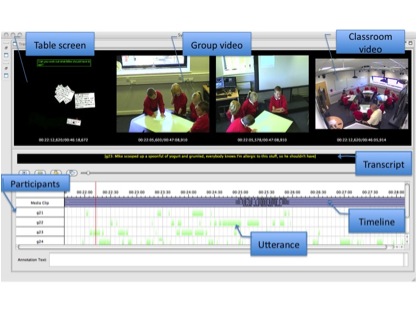
Networked content in use: Network Flick
Building on the Networked capabilities of the SynergyNet system, objects can be passed between tables. In the video below, the first group of school children pass images between their tables – to the excitement of the children and the SynergyNet team!
Networked Content
Since its inception, the SynergyNet content management system has supported networked content. The practical application of this is readily seen in the following video by James McNaughton. It shows two tables running side by side with content items being transferred by ‘flicking’ or ‘throwing’ towards the edge closest to the other table:
Replicating Tables
Here’s a sneak preview of our ability to replicate student tables onto the teacher console. Each view of the student’s table is, of course, a multi-touch element that can be moved, rotated, etc. Iyad has plans to do something quite amazing in the next iteration… stay tuned.
